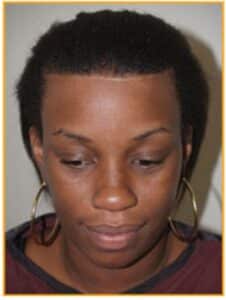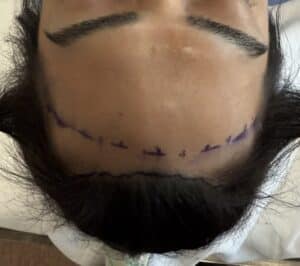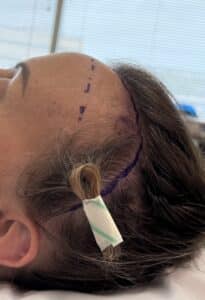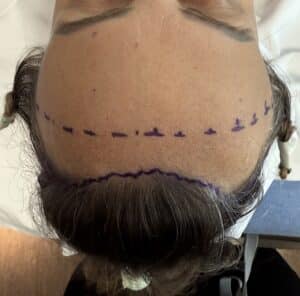Why a Perfectly Straight Hairline Looks Fake
When patients come in for hairline lowering (also known as forehead reduction) surgery, the main goal of most people is to reduce the height of the forehead while keeping the incision looking as inconspicuous as possible. When it comes to the forehead, a perfectly straight hairline can actually look unnatural and draw unwanted attention.
In this blog post, we’ll explore why hairline lowering surgery involves thoughtful incision design and how it can make all the difference in achieving a natural, flattering look.
Why a Straight Hairline Isn’t Natural
Let’s start with what a natural hairline actually looks like. Take a look at unaltered hairlines in both men and women, and you’ll notice that very few are truly straight across. The hairline tends to have natural dips and curves with varying density and thickness in hair follicles. It can rise slightly at the corners and curve gently along the sides. This natural irregularity helps frame the face in a soft, organic way.

When a hairline is made perfectly straight, it can look harsh, artificial, and almost mask-like. Our eyes are extremely sensitive to symmetry and patterns—which is why overly geometric changes to the face are so easily noticed. If there’s a single straight line across the forehead, the eye is immediately drawn to it, often in a way that disrupts the overall harmony of the face.

That’s why in hairline lowering surgery, careful incision design is everything.
Why a Straight and Square Hairline Looks Masculine
Another important consideration is how hairline shape influences perceived gender characteristics. In general, male hairlines tend to be more horizontal and square, with stronger corners at the temples. This squared-off look frames the upper face with harder angles, which is consistent with traditional masculine features.
In contrast, a feminine hairline typically has a more rounded contour with softer transitions at the sides. The center of the hairline may dip slightly, and the temples gently curve rather than form a strong corner. When someone desires a more feminine appearance, a straight and square hairline can actually work against that goal.
Common Incision Designs in Hairline Lowering Surgery
Hairline lowering typically involves a trichophytic and pretrichial incision, placed right at the junction of the forehead and the hair-bearing scalp. The goal is to remove a strip of forehead skin and bring the hairline forward to shorten the appearance of the forehead.
Here are a few common approaches:
Front Portion of the Incision:
1. Straight Incision
Some surgeons opt for a straight-line incision for simplicity or speed. While this can reduce operative time, it almost always results in a flat, artificial-looking hairline that doesn’t mimic natural anatomy.
2. Zigzag Incision
Often referred to as a “Charlie Brown closure,” this design involves intentionally zigzagging lines that help disrupt the visual continuity of the scar. While this hides better than a straight line, it is still more uniform than would be found in a natural hairline.

2. Irregularly Irregular Incision
An irregularly irregular incision is a term borrowed from medical training—originally used to describe the chaotic rhythm of atrial fibrillation. In surgical design, it refers to an incision pattern that lacks any consistent or predictable shape, unlike a straight line or a regular zigzag.
This randomness is precisely what makes it so effective for hairline lowering surgery. Because the human eye is drawn to symmetry and repeating patterns, an incision without any pattern at all blends more seamlessly with natural hair growth. It hides beautifully in the hairline, making the scar nearly imperceptible over time.

How I Design My Incisions to Avoid the “Straight Hairline”
In my practice, I take incision design very seriously. The hairline is one of the most visible features of the face, and if it doesn’t look natural, the entire result can be compromised—even if the surgical execution was flawless.
Here’s how I approach hairline incision design:
1. Extending the Incision Over the Ear, Not Back
One of the most important details is how the incision wraps around the sides. Instead of curving the incision backward (which can create a boxy, squared-off hairline), I bring the incision down over the top of the ear. This allows me to round off the sides of the hairline and avoid creating a strong corner at the temples.
This small but critical maneuver helps to soften the transition between the forehead and temple areas, keeping the hairline more feminine and flowing rather than angular.

2. Using an Irregularly Irregular Pretrichial Incision
At the front of the hairline, I never use a straight line. Instead, I create what’s known as an irregularly irregular incision – meaning the edges are not just curved or zigzagged but are uniquely patterned in a non-repetitive way. This mimics the natural, chaotic pattern of hair growth and allows hair to grow through the scar, making it nearly invisible over time.
This design breaks up the visual plane and avoids the harsh, unnatural appearance that straight lines can create on the face.

The Science Behind Why Straight Lines Stand Out
There’s a reason scar revision surgeons often use geometric broken lines to close incisions on the face: the human eye is highly attuned to symmetry and straight lines. When a line is too straight, it immediately catches the eye, signaling that something is man-made or altered.
In nature, straight lines are rare, especially on the human face. Our skin, muscles, and bones form gentle curves and soft contours. So when a straight incision is placed along the hairline, it disrupts the natural flow of the face.
In hairline lowering surgery, a straight hairline can make the surgical result look obvious—the exact opposite of what most patients want.
Why Natural Hairline Flow Is So Important
Beyond just aesthetics, a well-designed hairline complements your facial structure. A soft, curving hairline helps balance facial proportions, enhances femininity, and can even make the forehead and eyes look more youthful and open.
On the other hand, a poorly designed, straight hairline can clash with natural facial angles, make the forehead appear too flat or broad, and result in an obvious “done” look.
Your incision shouldn’t just be about closing the skin—it should be about enhancing your features in a way that feels seamless and organic.
What to Look for in a Surgeon
If you’re considering hairline lowering surgery, make sure your surgeon is experienced in designing incisions that prioritize natural appearance over simplicity. Ask to see before-and-after photos, and pay attention to the shape of the hairline, particularly at the sides.
Here are a few questions to consider:
Does the hairline curve softly at the sides or form harsh angles?
Is there visible scarring, or does the hair appear to grow naturally through the incision line?
Does the hairline complement the patient’s facial structure?
The right surgeon will take the time to individualize your incision pattern based on your anatomy and goals—not just draw a line and start cutting.
Avoiding the “Straight Hairline Trap”
Hairline lowering surgery is an incredibly powerful procedure for transforming facial balance and confidence. But the artistry lies in the details—especially the incision.
By designing the incision with the same care as the rest of the surgical plan, we can achieve results that look natural, harmonious, and beautifully undetectable.
If you’re thinking about hairline lowering and want a result that feels like you — not like surgery — make sure to prioritize incision design. Because in facial plastic surgery, the most successful procedures are the ones you can’t even tell were done.
Are you interested in hairline lowering surgery? Schedule a consultation in our Austin or Dallas locations to learn more about how this powerful procedure!
You May Also Like:
- Hairline Lowering vs Hair Grafts: Understanding Your Options for a Better Hairline
- Hairline Lowering Before and After Gallery
- Forehead Reduction Surgery Gone Wrong: Cautionary Tales and Prevention Strategies
- How to Camouflage Your Hairline Lowering Incision After Surgery
- Top 5 Things You Wish You Knew Before Hairline Lowering Surgery